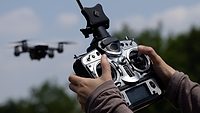Fresh C-sUAS solutions are needed to defeat airport drone risks

When a drone came within 100 feet of a descending airplane in late June, police in Glasgow felt a clear sense of deja vu.
For years, the news media has been filled with stories of rogue drones veering into private airspace and coming dangerously close to commercial airliners. This time, the event happened over the skies of Scotland, when the pilot of a plane approaching the runway of Glasgow’s Paisley Airport saw and reported an illegally operated unmanned aerial vehicle (UAV) just in the nick of time.
When it comes to safety in the air, drones present one of the most pernicious threats to an aircraft at both takeoff and landing. Airplanes are at the highest risk when flying at low altitudes, and as drones become cheaper, smaller and more ubiquitous, the number of near-miss incidents in the sky continues to climb.
July’s incident in Glasgow was the fourth such close call in the U.K. alone this year. In May, an incoming passenger flight to Edinburgh nearly collided with a drone at 2,200 feet. Two different air ambulance helicopters were practically sideswiped by passing drones while transporting passengers or attempting to land on hospital rooftops.
But the problem is global. In recent years, airports in cities as varied as Newark, Dublin and Dubai have all grounded planes after drones were spotted near the runway. In one of the most widely reported and disruptive events, the runway at Gatwick Airport outside of London was shut down for 33 hours in 2018 at the cost of nearly $70 million.
There is no doubt that drones, both big and small, present a clear danger to planes and their passengers. Ignoring the threat can lead to catastrophe, both business loss and human life. The question is no longer whether drones are an issue above our runways. The question is how to defend against them.
The various dimensions of airport drone threat
Drone threats to airports do not come in a one-size-fits-all model. There are, in fact, multiple distinct categories of risk: accidental collision, deliberate attacks, and hostile surveillance and espionage.
Since a plane’s ability to maneuver and alter course is most limited at landing and takeoff, both of which bring the plane into low altitudes where drones are most likely to be present, the threat is most elevated when the plane is flying just above the runway.
Mid- and large-size drones can carry payloads, making them particularly dangerous. But even when explosives are not at play, these larger UAVs can do significant damage to aircraft. These include shattered windshields, lost optics and penetration and inhalation hazards, which ultimately require emergency landings after impact, according to the Canada National Research Council’s Aerospace Research Center.
At low speeds of around 140 knots, aircraft that collided with drones showed plastic damage and extensive deformation to the aircraft skin, as well as damage to the vessel’s underlying honeycomb structure. At higher speeds of 250 knots, severe deformation of slat curvature, secondary damage to the leading edge and even penetration of drone debris into the aircraft’s fractured area have been observed.
Given all these variables, it’s clear that a proper drone defense strategy requires a differentiated approach to correspond with the multi-faceted threat. A counter-drone strategy should start with understanding both the most accessible as well as the most dangerous drones that present the most significant threat and then calibrate a comprehensive, targeted and flexible defense strategy.
Traditional C-UAS technology is not suitable for airports
Standard counter-drone mitigation technology presents significant issues when applied near civil and commercial aircraft.
Jammer-based solutions, for example, may disrupt drone communications, but they also can potentially hamper other crucial communications systems in the area. In an airport, this is especially sensitive and highly problematic.
Kinetic “hard-kill” solutions, such as shooting down a rogue UAV with some sort of projectile, are risky in all crowded situations because they can cause collateral damage. Airports are crowded, and low-flying aircraft are difficult to maneuver in these situations.
A fresh approach is needed
A fresh anti-drone mitigation approach is needed for airports, along with appropriate and aligned regulations. To keep airport airspace safe, qualified and authorized security agencies should be able to take control of a hostile drone or drone swarm situation.
New cyber takeover technologies represent a fresh and innovative approach. A cyber takeover involves authorized security agency personnel disconnecting the drone from its remote control, taking over the drone, and then sending the rogue drone via a safe route to landing. All of this must happen without interfering with legitimate authorized drones and communication signals in the vicinity. Cyber takeover systems do not rely upon jammers or kinetic technology. As such, they avoid collateral damage, interference, disruption or disturbance. Continuity is preserved as communications, commerce, transportation and everyday life proceed smoothly.
Focusing on the real risk and using the most suitable technology, along with appropriate legislation, would result in neutralized threats while allowing the uninterrupted functioning of airports and aircraft. This approach would lower the risk at low altitude levels and increase levels of safety, control and continuity.
This article originally ran in Security, a twice-monthly security-focused eNewsletter for security end users, brought to you by Security Magazine. Subscribe here.
Looking for a reprint of this article?
From high-res PDFs to custom plaques, order your copy today!






